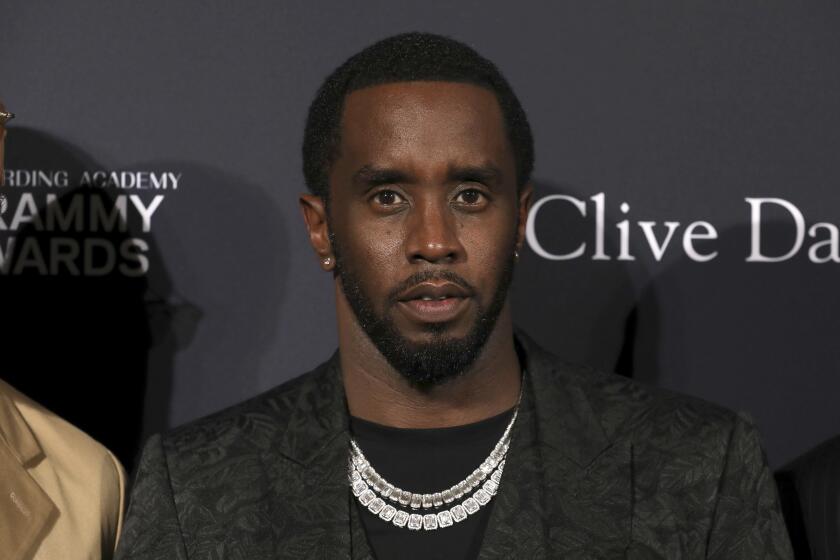Review: What âSpringsteen on Broadwayâ gets wrong about the Bossâ job
Reporting from New York â Bruce Springsteen opens his new Broadway show with some terrifically unnecessary advice â namely, an accounting of some of the attributes you might find helpful âif you ever come face to face with 80,000 screaming rock ânâ roll fans.â
The singer drew from real-life experience, of course, in compiling his list, which includes natural ability, study of craft and âa naked desire for fame.â As one of rockâs biggest superstars â and a widely acknowledged spokesman for everyday folks â Springsteen has spent decades playing arenas and stadiums, inducing massive crowds to sing along to every word of indelible hits like âBorn to Runâ and âBorn in the U.S.A.â
But 80,000 screaming fans isnât just a sight you and I are unlikely ever to encounter. Itâs also a sight the singer himself avoids in âSpringsteen on Broadway,â which was to open Thursday evening here at the Walter Kerr Theatre.
ANOTHER TAKE: âSpringsteen on Broadwayâ is a rock-star confessional with heart
In this limited sold-out engagement, set to run through early February, heâs playing for fewer than 1,000 people a night in one of Broadwayâs cozier houses. And theyâre not allowed to scream.
âIâll handle it myself,â Springsteen said tersely as audience members began lifting their voices for his song âDancing in the Darkâ during a preview performance I attended Wednesday.
The command was surprising, startling even â a radical disruption of the squishy communal vibe that has defined Springsteenâs concerts for as long as anyone can remember.
So, meet the new Boss, somewhat less gregarious than the old Boss.
The performer said he was inspired by a gig he played at the White House in January, shortly before President Obama split, and âSpringsteen on Broadwayâ strips almost everything away from the action-packed presentation this 68-year-old New Jersey native has perfected with the help of his long-running E Street Band.
The two-hour show puts Springsteen, wearing a black T-shirt and jeans, in the middle of a stage thatâs empty except for a piano, a stool, a water glass and several beat-up road cases; behind him, a brick wall looms, suggesting the side of an old factory or maybe a Catholic church. Every once in a while, a stagehand walks out and gives him an acoustic guitar, and Springsteen uses either the guitar or the piano to accompany himself as he sings songs and tells stories adapted from his impressive 2016 memoir, âBorn to Run.â
On Wednesday, the singerâs wife, Patti Scialfa (whoâs also a member of the E Street Band), joined him for two songs. But thatâs about it as far as production goes in a concert that feels infinitely smaller than, say, the epic blowouts Springsteen devised last year to close out the now-demolished Los Angeles Sports Arena.
Actually, there is one way in which âSpringsteen on Broadwayâ is bigger than a normal Boss gig, and thatâs the price of tickets, which topped out at $850 each before they sold out almost instantly â and then cropped up on StubHub at even crazier prices. (As I write this, a ticket for Friday night, in a center-orchestra seat several rows behind where I sat, is going for $2,800.)
Even the face-value numbers are âridiculous,â said Micki Mersky of Short Hills, N.J., who told me sheâd paid $850 as we entered the theater â one contribution toward the $2.3 million that âSpringsteen on Broadwayâ rang up in its first week of previews, according to the Broadway League.
Another show-goer, who gave his name only as Bruce, was more blunt when I talked with him and his twentysomething son after the concert.
âItâs stupid, and heâs greedy,â he said of Springsteen. âHe doesnât need this much money.â
Then again, this Bruce had forked over the bucks to see that Bruce. And he said he and his kid were coming back in two weeks.
You can understand the allure. As the lights went down inside the Walter Kerr and Springsteen emerged from the wings to take his position, the moment carried an undeniable electricity â the feeling that we were in for something new.
Plenty of rockers have done the acoustic-on-a-stool thing, including Springsteen, who taped a memorable episode of âVH1 Storytellersâ in 2005. And Broadway has hardly suffered from a lack of attention from the electric-guitar brigade; Sting, U2, Paul Simon and Green Day all have written musicals, to varying degrees of success.
But âSpringsteen on Broadwayâ isnât a concert or a musical. With its scripted dialogue and its precisely calibrated musical arrangements â at times, you could hear the clicking of Springsteenâs fingers on his guitar strings â the production is looking for some unexplored middle ground between the two: It wants to use theatrical convention to bring the audience into Springsteenâs mind, not to celebrate but to illuminate.
He begins at the beginning, strumming âGrowinâ Upâ as he talks about his discovery of music as an escape from the âlifeless black holeâ of school and church and green beans for dinner. He describes a giant tree in the front yard of his childhood home in Freehold, N.J.; he recalls being sent by his mother to fetch his dad at one of the smoky bars he refers to as âcitadels of mystery.â
This part of the show, set to âMy Hometownâ and âMy Fatherâs Houseâ and âThe Wish,â is remarkable â a mesmerizing half-hour or so in which you almost forget youâre in a theater surrounded by other people, so evocative are his images and so natural his shifts between singing and talking.
Soon heâs moving on to recount his early days as a singer and his efforts to assemble the E Street Band, which never had the âbest players,â he says, but it didnât matter â the group had the right players.
In âTenth Avenue Freeze-Out,â he takes a lengthy digression to pay tribute to the late E Street saxophonist Clarence Clemons, who died in 2011; he uses âThe Promised Landâ and âBorn in the U.S.A.â to fill out a moving tale about a long-ago road trip to California, where he met author Ron Kovic at the Sunset Marquis â âan upscale lowlife kind of place,â per Springsteenâs vivid description.
Heâs good too with Scialfa as they do âTougher Than the Restâ and âBrilliant Disguise,â both with a sense of lived intimacy that puts across some of what they must see in each other.
Throughout all this, I scarcely thought about the fact that Springsteen was using a prompter for his dialogue â either because he wasnât looking at it that often or because his performance kept my attention from the very large monitor hanging from the front of the mezzanine.
But that changed in the second half of the show, which moves away from the specifics of Springsteenâs life and into a more philosophical mode as he sings tunes like âThe Risingâ and âLong Walk Home.â
During the latter, he describes âmen in torchlight paradesâ and refers to the current moment â the Trump era, one presumes, though he didnât utter the name â as a âbad chapter in the ongoing battle for the soul of our nation.â
Politics has always been tricky for Springsteen, who was arguably propelled to stardom by a blue-collar fan base we might now classify with the color red.
After the show, I stood on the street and talked with Fred Jenny, a fan from Verona, N.J., who pointed out that âBruce took a little bit of a beating in his career when he did âAmerican Skin,ââ a song from the early 2000s about the New York police shooting death of Amadou Diallo. âAnd I think from that point on, he kind of softenedâ the political content in his music, Jenny said.
Perhaps that was why Springsteen seemed to be following the prompter more closely â sticking to a carefully strategized script â as the concert touched on issues that stood to divide his audience.
At least thatâs how it struck me. Jarrod Roy, a young guy from Lafayette, La., who said he cried through half the show, told me he thought the Trump stuff felt lightly handled.
âBruce thinks whatâs going on now will fade,â Roy said.
And Springsteen would probably say Roy is right. Near the end of âSpringsteen on Broadway,â the singer quotes Joe Strummer of the Clash, insisting the future hasnât been written yet. He recalls taking a recent trip to his old home in Freehold and discovering that the giant tree had been cut down.
âBut somehow we remain,â he says, a bit ponderously.
Here he seemed to be working up to the kind of optimism Springsteen dispenses in his big arena shows, moving us out of his head and back into a wider space.
But then the thing kind of fell apart. Nobody on Wednesday had tried with any seriousness to sing along until âDancing in the Darkâ; it hadnât felt appropriate, or even possible, in a way.
When that changed, though, it turned out that Springsteen wasnât ready for it, which felt almost like a betrayal. Earlier, his inward focus had seemed like a gift, but now it had a punishing quality that only deepened when he closed the concert with a dour, blah-sounding rendition of âBorn to Run.â
Heâd taken away the joy and the release that the E Street Band doles out but was no longer replacing it with any fresh introspection; you suddenly longed to be in a much larger room with many more people.
As he sang all by himself about a ârunaway American dream,â I couldnât help but think about something Iâd talked about earlier with Mersky and her friend Sheryl Cohen.
They said they regarded Springsteen as the ultimate rocker, so I asked them if they could imagine anyone else doing this kind of unique engagement. Mersky said no way, but Cohen thought of another Jersey icon, Jon Bon Jovi, which made Mersky scoff.
âBon Jovi doesnât relate like Springsteen relates to the working people,â she said, and maybe thatâs true.
But Iâm confident that Bon Jovi â whose lightweight reputation means heâs as unlikely as I am to play Broadway â wouldâve understood easily when his people needed to feel as though they belonged.
Twitter: @mikaelwood
ALSO
Why losing Tom Petty feels like losing a piece of ourselves
Pink on her new album, Billy Joel and why sheâs over pop-star feuds
How Taylor Swift gave Clive Davis the idea for Johnny Mathisâ âGreat New American Songbookâ
More to Read
The biggest entertainment stories
Get our big stories about Hollywood, film, television, music, arts, culture and more right in your inbox as soon as they publish.
You may occasionally receive promotional content from the Los Angeles Times.











